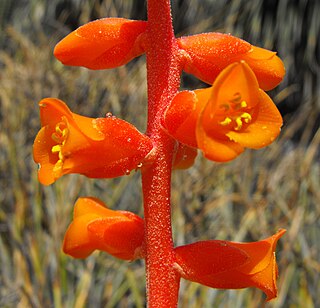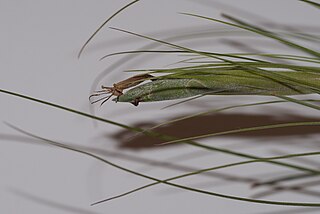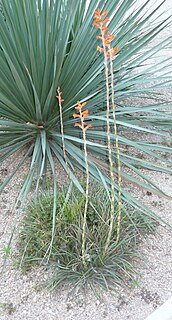
Cryptanthus is a genus of flowering plants in the family Bromeliaceae, subfamily Bromelioideae. The genus name is from the Greek cryptos (hidden) and anthos (flower). This genus has two recognized subgenera: the type subgenus and HoplocryptanthusMez. All species of this genus are endemic to Brazil. The common name for any Cryptanthus is "Earth star".

Dyckia leptostachya is a plant species in the genus Dyckia. This species is native to Brazil, Bolivia, Paraguay, and Argentina.

Dyckia brevifolia, or sawblade, is a species of flowering plant in the Bromeliaceae family. This species is endemic to Brazil.
Dyckia hatschbachii is a plant species in the genus Dyckia. This species is endemic to Brazil.

Dyckia maritima is a species of flowering plant in the Bromeliaceae family. This species is endemic to Brazil. This is an ornamental bromeliad.
Dyckia martinellii is a plant species in the genus Dyckia.
Dyckia agudensis is a plant species in the genus Dyckia. This species is native to Brazil.
Dyckia mezii is a species of stiff-leaved thorny plant in the genus Dyckia. This species is native to Brazil. Dyckia argentea is an illegitimate name for the same species.
Dyckia bracteata is a plant species in the genus Dyckia. This species is native to Brazil.

Dyckia fosteriana is a plant species in the genus Dyckia. This species is native to Brazil.

Dyckia microcalyx is a species of flowering plant in the Bromeliaceae family. This species is native to Argentina, Paraguay and Brazil.
Dyckia pernambucana is a plant species in the genus Dyckia. This species is native to Brazil.

Dyckia trichostachya is a species of flowering plant in the Bromeliaceae family. This species is endemic to Brazil, and native in Goiás state.

Dyckia tuberosa is a plant species in the genus Dyckia. This species is native to Brazil.

Tillandsia gardneri is a species in the genus Tillandsia. This species is native to Trinidad & Tobago, Colombia, eastern Brazil and Venezuela.

Tillandsia juncea is a species in the genus Tillandsia. This species is native to northern South America, Central America, Mexico and the West indies.
Dyckia macedoi is a plant species in the genus Dyckia. It is endemic to the State of Minas Gerais in Brazil.

Dyckia marnier-lapostollei is a plant species in the genus Dyckia, endemic to Brazil.

Dyckia rariflora is a plant species in the genus Dyckia endemic to the State of Minas Gerais in Brazil.

Dyckia remotiflora is a plant species in the genus Dyckia. It is native to Argentina, Uruguay, and Brazil.












